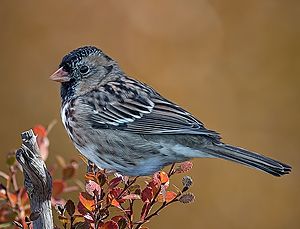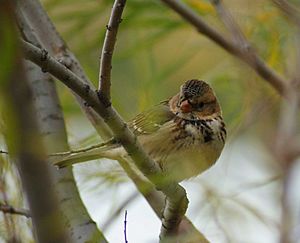Harris's sparrow facts for kids
Quick facts for kids Harris's sparrow |
|
|---|---|
 |
|
| Conservation status | |
| Scientific classification | |
| Genus: |
Zonotrichia
|
| Species: |
querula
|
 |
|
The Harris's sparrow (Zonotrichia querula) is a large sparrow. It is known for its unique black and white head markings. These birds breed in the northern parts of central Canada. This includes the Northwest Territories and Nunavut. They also breed a little in northern Manitoba and Saskatchewan. This makes it Canada's only bird that breeds only there. In winter, they migrate south. They fly to the Great Plains states in the United States. This area stretches from southern South Dakota to central Texas. The bird is named after Edward Harris, an American bird expert from the 1800s.
Contents
About the Harris's Sparrow
This sparrow is the biggest in its bird family, called Passerellidae. It grows to be about 17 to 20 centimeters (7 to 8 inches) long. Its wings can spread about 27 centimeters (11 inches) wide. It usually weighs between 26 and 49 grams (about 1 to 1.7 ounces).
Appearance
Harris's sparrows look very special. When they are ready to breed, their bills are pink. They have black feathers on their head, face, throat, and upper chest. The sides of their head and neck are grey. Their back is brown with strong black stripes. They also have two white bars on their wings. Their lower belly is white, sometimes with black spots.
Non-breeding adults look more buffy (a yellowish-tan color). They have less black on their heads and throats. Young birds have even less black. They usually have a white chin and throat. They also have a black stripe near their mouth and a wide, smudgy black band on their chest. Very young birds have a brownish head with black streaks. They also have fine dark streaks on their underside. These birds change their feathers from July to September.
Bird Song
The Harris's sparrow often sings from a high spot. Its song is a series of clear, high, wavering whistles. These are followed by more whistles that are higher or lower in pitch. They also make a strong, metallic "chink" sound. Sometimes, they make variable musical twittering sounds too.
Where Harris's Sparrows Live
Harris's sparrows breed in small, coniferous forests. They also live in nearby scrub areas. They especially like parts of the large boreal forests. Here, spruce trees grow next to mossy bogs. They often build nests near the northern edge of where trees grow. This area is called the forest-tundra ecotone.
Typical plants in their breeding areas include white and black spruce trees. There are also American larch trees. You can find dwarf birch and willow bushes. Wet sedge meadows and shrubby tundra are also common.
When they migrate, they mostly fly through tallgrass prairies. In winter, they live in open woodlands. They also like woodland edges, clearings, and thick bushes. You might see them around brush piles. Harris's sparrows often visit bird feeders in gardens during winter. They usually stay away from dry, shortgrass prairies and very dense woods in winter.
Harris's Sparrow Behaviour
Migration
Harris's sparrows start their spring migration around late February. They arrive at their breeding grounds by May. They reach their winter homes as early as late October. Most arrive during November and early December. Records show they use mountain valleys as migration paths. In the fall, their migration is less strict. They often wander around Canadian prairie provinces. They only fly south when the weather gets very harsh.
Feeding Habits
Harris's sparrows usually look for food on the ground. They scratch strongly in leaves and soil to find food. During nesting, about 85% of their foraging is done by picking food from the ground. In the breeding season, they usually look for food alone or with their mate.
Their main food (about 66% of what breeding birds eat) is seeds. These seeds mostly come from Carex sedges, grasses, and Scirpus bulrush. They also eat fruits during the breeding season. These include black crowberry, mountain bearberry, and different Vaccinium berries. Pine needles, flower buds, and blossoms are also eaten.
From June to September, insect larvae are important in their diet. This is when more insects are available. They like to eat beetles, flies, bees, ants, moths, butterflies, spiders, cicadas, aphids, and leafhoppers. We know less about what wintering Harris's sparrows eat.
Social Life
Male Harris's sparrows often gather to sing at dusk. In winter, flocks of these sparrows have a pecking order. This order decides who gets food and good roosting spots. The oldest males are usually the most dominant. They often have the largest black patches on their chests.
Sometimes, males have "jump fights." Birds face each other, then jump up. They peck, claw, and hit each other with their wings. If young birds have their feathers dyed black to look like a large bib, they move up in the pecking order. They become more dominant than females and other young males. In winter, they are usually found in flocks of up to several dozen birds. Some birds often wander outside their normal range. They might join flocks of other sparrow species.
Reproduction
Breeding pairs set up a territory of about 2 hectares (5 acres). Nests are usually built in early to mid-June. Eggs are typically laid from late June to July. This depends on when the snow melts in their habitat.
Harris's sparrows hide their nests well on the ground. They place them under a thick bush or a small conifer tree. Sometimes, they are in a mossy dip in thick grass clumps. Both parents build a cup nest. They use twigs, grass, moss, and lichens. They line it with fine grasses.
They lay three to five eggs. The eggs can be greenish or greyish. They have different amounts of small reddish-brown spots. Each egg is about 22.2 x 16.5 millimeters (0.87 x 0.65 inches) in size. They weigh about 3.3 grams (0.12 ounces). The eggs hatch in about 13.5 days. The chicks weigh about 3.1 grams (0.11 ounces) when they hatch. The young birds leave the nest in about 8 to 10 days. This usually happens from July 4 to July 13. About 3 weeks after leaving the nest, the young birds can live on their own. If the first nest is destroyed, parents might lay a second set of eggs.
This sparrow is one of the least studied North American sparrows. This is because its nesting area is so isolated. The very first nest found was in 1931. It was discovered in Churchill, Manitoba, by George M. Sutton. This was 91 years after the bird was first described!
Life Span and Dangers
A Harris's sparrow has been known to live for up to 11 years and 8 months in the wild. Predators that hunt nests include different land mammals. These can be Arctic ground squirrels and stoats. Harris's sparrows are easy targets because their nests are on the ground.
Canada jays, northern shrikes, and merlins can also be serious predators. They hunt both nestlings and adult birds. Shrikes, sharp-shinned hawks, and great horned owls are known to hunt Harris's sparrows in winter.
When startled by other animals, Harris's sparrows fly up into trees. They usually make an alarm call, which sounds like "weenk." If threatened by other birds, they duck down to the ground. They also make alarm calls to warn other sparrows of danger.
Conservation Status
The IUCN says this species is "near threatened". This means it could become threatened in the future. The total breeding population is thought to be about 2 million birds. However, fewer Harris's sparrows have been seen in yearly Christmas Bird Counts. This has led to the species being on the "Audubon Watchlist."
This bird can adapt well to different winter homes and food sources. Its habitat is also isolated, so human development doesn't affect it much. This makes the recent decline in numbers a bit of a mystery. The species breeds at the northern edge of boreal forests. It is possible that changes in their breeding habitat are affecting them. The boreal forest has been impacted by heavy logging. It has also been affected by more wildfires and poorer soil quality. Both of these problems are likely connected to global climate change.
See also
 In Spanish: Chingolo de Harris para niños
In Spanish: Chingolo de Harris para niños



